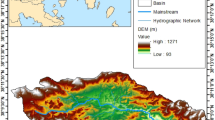Abstract
Climate change impacts on cities are likely to require changes in urban adaptation planning. Despite the low degree of climate change manageability, the Nature-Based Solutions (NBS) are considered resilient measures that integrate the ecological dimension into spatial planning while playing a crucial role in addressing societal challenges and multiple benefits.
In urban planning, ecosystem models can be used to develop flood management strategies even if the limited experience with models and model output is a challenge for planners in thinking about addressing potential climate change impacts effectively. Consequently, this new challenge is based on the need for spatially explicit biophysical assessment related to NBS scenarios’ implementation.
This study considers the urban flood vulnerability assessment and how these vulnerabilities can be reduced through NBS simulation scenarios in a small-sized Italian coastal city of the Liguria Region. To quantify the amount of runoff during extreme rainfall events while identifying the greatest critical areas, the Urban Flood Risk Mitigation model (InVEST) integrated into a GIS environment have been employed. Furthermore, the biophysical assessment of NBS implementation has been supported by highlighting the crucial role of biodiversity type.
Access this chapter
Tax calculation will be finalised at checkout
Purchases are for personal use only
Similar content being viewed by others
References
Aerts, J.C.J.H., Botzen, W.J.W., Emanuel, K., Lin, N., de Moel, H., Michel-Kerjan, E.O.: Evaluating flood resilience strategies for coastal megacities. Science 344(6183), 473–475 (2014). https://doi.org/10.1126/science.1248222
Rosenzweig, B., et al.: Developing knowledge systems for urban resilience to cloudburst rain events. Environ. Sci. Policy 99, 150–159 (2019). https://doi.org/10.1016/j.envsci.2019.05.020
Berndtsson, R., et al.: Drivers of changing urban flood risk: a framework for action. J. Environ. Manage. 240, 47–56 (2019). https://doi.org/10.1016/j.jenvman.2019.03.094
IPCC Summary for policymakers. In: IPCC Special Report on the Ocean and Cryosphere in a Changing Climate. Pörtner, H.-O., Eds., et al. (2019). ISBN 978–0–521–88010–7.
Grêt-Regamey, A., Altwegg, J., Sirén, E.A., van Strien, M.J., Weibel, B.: Integrating ecosystem services into spatial planning—a spatial decision support tool. Landsc. Urban Plan. 165, 206–219 (2017). https://doi.org/10.1016/J.LANDURBPLAN.2016.05.003
McPhearson, T., Andersson, E., Elmqvist, T., Frantzeskaki, N.: Resilience of and through urban ecosystem services. Ecosyst. Serv. 12, 152–156 (2015). https://doi.org/10.1016/j.ecoser.2014.07.012
Brunetta, G., et al.: Territorial resilience: toward a proactive meaning for spatial planning. Sustain. 11, 1–17 (2019). https://doi.org/10.3390/su11082286
Dushkova, D., Haase, D.: Not simply green: nature-based solutions as a concept and practical approach for sustainability studies and planning agendas in cities. Land 9(1), 19 (2020). https://doi.org/10.3390/land9010019
Quagliolo, C., Comino, E., Pezzoli, A.: Experimental flash floods assessment through urban flood risk mitigation (UFRM) model: the case study of Ligurian coastal cities. Front. Water 3, 1–16 (2021). https://doi.org/10.3389/frwa.2021.663378
Eli, R.N., Lamont, S.J.: Curve numbers and urban runoff modeling - application limitations. In: Proceedings of the Low Impact Development 2010: Redefining Water in the City - Proceedings of the 2010 International Low Impact Development Conference; San Francisco, CA, USA, vol. 41099, pp. 405–418 (2010)
USDA - United States Department of Agriculture Hydrologic Soil-Cover Complexes. In: National Engineering Handbook: Part 630 - Hydrology (2004)
Sharp, R., et al.: InVEST 3.9.0. User’s Guide. The Natural Capital Project. https://storage.googleapis.com/releases.naturalcapitalproject.org/invest-userguide/latest/index.html. Accessed 12 Apr 2021
Albert, C., et al.: Planning nature-based solutions: principles, steps, and insights. Ambio 50(8), 1446–1461 (2020). https://doi.org/10.1007/s13280-020-01365-1
Davies, C., Lafortezza, R.: Transitional path to the adoption of nature-based solutions. Land Use Policy 80, 406–409 (2019). https://doi.org/10.1016/j.landusepol.2018.09.020
Li, Y., Huang, Y., Ye, Q., Zhang, W., Meng, F., Zhang, S.: Multi-objective optimization integrated with life cycle assessment for rainwater harvesting systems. J. Hydrol. 558, 659–666 (2018). https://doi.org/10.1016/j.jhydrol.2018.02.007
UNaLab: Nature Based Solutions – Technical Handbook, Part II (2019)
Ministero dell’ambiente e della tutela del territorio e del mare - Direzione Generale per il Clima, l’Energia e l’Aria Piano Nazionale di Adattamento ai Cambiamenti Climatici (PNACC 2017) - Contribution (2017)
Colombari, L.: Funzionalità Dei Sistemi Informativi Geografici (Gis) Nella Risoluzione Del Conflitto Tra Uso Del Suolo. In: Area Urbana E Gli Effetti Del Cambiamento Climatico - Il Caso Di Genova E Del Quartiere Certosa - CAMPASSO, Università degli Studi di Torino (2020)
Kabisch, N., Korn, H., Stadler, J., Bonn, A.: Nature-based solutions to climate change adaptation in urban areas—linkages between science, policy and practice. In: Kabisch, N., Korn, H., Stadler, J., Bonn, A. (eds.) Nature-based Solutions to Climate change Adaptation in Urban Areas. TPUST, pp. 1–11. Springer, Cham (2017). https://doi.org/10.1007/978-3-319-56091-5_1
Author information
Authors and Affiliations
Corresponding author
Editor information
Editors and Affiliations
Rights and permissions
Copyright information
© 2021 Springer Nature Switzerland AG
About this paper
Cite this paper
Quagliolo, C., Comino, E., Pezzoli, A. (2021). Nature-based Simulation to Address Climate Change-Related Flooding. Preliminary Insights on a Small-Sized Italian City. In: Gervasi, O., et al. Computational Science and Its Applications – ICCSA 2021. ICCSA 2021. Lecture Notes in Computer Science(), vol 12955. Springer, Cham. https://doi.org/10.1007/978-3-030-87007-2_39
Download citation
DOI: https://doi.org/10.1007/978-3-030-87007-2_39
Published:
Publisher Name: Springer, Cham
Print ISBN: 978-3-030-87006-5
Online ISBN: 978-3-030-87007-2
eBook Packages: Computer ScienceComputer Science (R0)




